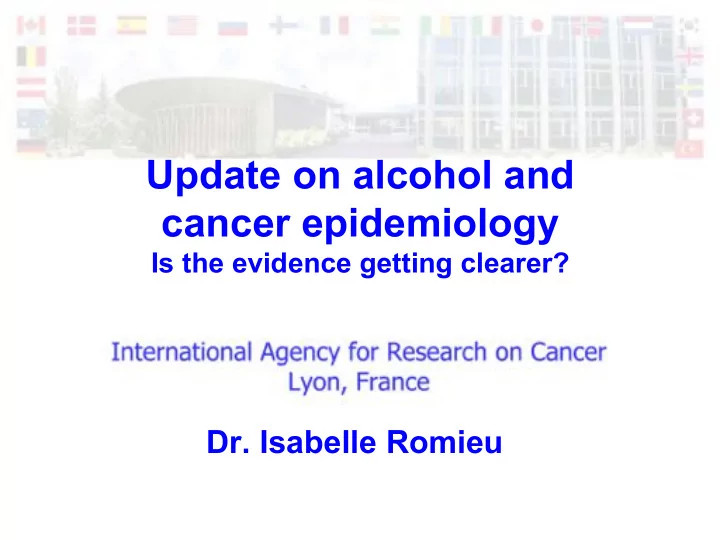

Update on alcohol and cancer epidemiology Is the evidence getting clearer? Dr. Isabelle Romieu
Key Facts • Alcohol is the world’s third largest risk factor for disease burden • More than 1.9 billion adults ( ≥ 15 years old) are regular alcohol consumers, with an average daily consumption of 13 g of ethanol (~one drink). • There are around 2.5 million alcohol-related deaths each year • 320 000 (12.8%) of alcohol-related deaths are among young people (15-29 years old) WHO Management of substance abuse Global status report on alcohol and health 2011
Global distribution of all alcohol- attributable deaths by disease WHO 2011
Total adult per capita consumption Global Information System on Alcohol and Health Best WHO 2005 estimates using average recorded alcohol consumption 2003-2005. Data from 147 countries (88% of the world population).
Alcohol-attributable deaths Global status report on alcohol and health 2011
IARC evaluation (Vol. 100E) • The Working Group confirmed previous conclusion (Vol. 44, 1988): - Cancers of the oral cavity, pharynx, larynx, oesophagus and liver are causally related to the consumption of alcoholic beverages. - There is sufficient evidence for breast cancer in women and colorectal cancer Overall evaluations: Group 1 • Alcoholic beverages are carcinogenic to humans • Ethanol in alcoholic beverages is carcinogenic to humans • Acetaldehyde is carcinogenic to humans IARC Monograph 2009
Dose-cancer risk relationship (UADT) Oral cancer Laryngeal cancer Laryngeal cancer Laryngeal cancer Laryngeal cancer Pharyngeal cancer Oesophageal cancer Oesophageal cancer Oesophageal cancer Oesophageal cancer Turati2010, Islami 2010, Fang 2011
Dose-cancer risk relationship Colorectal cancer Breast cancer Liver cancer Hamajima 2002 Fedirko 2011 Rehm 2011
Alcohol drinking and colorectal cancer Fedirko 2011
Alcohol Attributable Burden of Cancer Incidence-EPIC Men Women Total 10% (7% to 13%) 3% (1% to 5%) UADT 44% (31% to 56%) 25% (5% to 46%) Liver 33% (11% to 54%) 18% (-3% to 38%) Colorectal 17% (10% to 25%) 4% (-1% to 10%) Breast - 5% (2% to 8%) Based on 8 countries: France, Italy, Spain, UK, the Netherlands, Greece, Germany, Denmark ( env. 350,000 individuals) Schutze M, 2011
Binge drinking by age (USA) National Survey on Drug Use and Health, 2010
Alcohol intake and BC by drinking pattern Chen et al., 2011
Alcohol intake and BC by age at consumption Chen et al., 2011
Genetic susceptibility • Role of polymorphisms in enzymes involved in ethanol and acetaldehyde metabolism ( ADH, ALDH) • May explain inter-individual differences of susceptibility to alcohol • Role of polymorphism of genes involved in nutrient metabolism e.g. MTHFR that acts on folate metabolism
Alcohol metabolism CATALASE Direct effects H 2 O 2 2H 2 O ALDH ADH ACETATE ETHANOL ACETALDEHYDE NAD + NAD + NADH NADH CYP2E1 Indirect effects NADP + NADPH
Alcohol and Oesophageal cancer ALDH2*1/*2 vs ALDH2*1/*1 Fang et al. 2011
A lcohol-folate interaction and BC Zhang et al., 2005
MTHFR -alcohol interaction Alcohol consumption (tertiles) P - Medium High P -trend interaction Colorectal cancer 0.31 CC/CT (cases/controls) 96/124 80/175 Adjusted OR (95% CI) 1.12 (0.78, 1.60) 1.87 (1.29, 2.71) <0.001 TT (cases/controls) 25/26 33/33 Adjusted OR (95% CI) 1.01 (0.55, 1.85) 0.89 (0.51, 1.54) 0.700 Colon cancer 0.70 CC/CT (cases/controls) 96/68 80/85 Adjusted OR (95% CI) 1.75 (1.12, 2.72) 2.60 (1.63, 4.12) <0.001 TT (cases/controls) 25/11 33/16 Adjusted OR (95% CI) 1.28 (0.58, 2.79) 1.20 (0.60, 2.42) 0.282 Rectal cancer 0.40 CC/CT (cases/controls) 96/43 80/73 Adjusted OR (95% CI) 0.80 (0.50, 1.30) 1.78 (1.13, 2.82) 0.001 TT (cases/controls) 25/9 33/14 Adjusted OR (95% CI) 0.84 (0.36, 1.95) 0.84 (0.41, 1.72) 0.581 Kim et al., 2012
Conclusions and Perspectives • Alcohol causes several cancers: oral cavity, pharynx, larynx, oesophagus, and colorectal, liver and female breast. • The adverse effect is observed even with light ( <= 1 drink/day) alcohol consumption. • Increasing alcohol consumption increases risk in a dose-dependent manner • No specific difference in alcoholic beverages and ethanol content and acetaldehyde appears the common factor related to the increased risk of cancer • Alcohol carcinogenesis may be modulated by the activity of several polymorphisms in enzymes involved in ethanol and/or acetaldehyde and some nutrient metabolism.
Conclusions and Perspectives (2) Further epidemiological studies should: • Used standardized drinking exposure (g of ethanol vs volume of alcoholic beverage). • Focus on drinking pattern ( e.g Binge drinking) and determine the effect of cumulative vs current intake • Explore the possibility of a susceptibility window during adolescence and the role of age-started dinking? • Explore modulators of effects: nutrient intake such as folate and genetic susceptibility • Explore epigenetic changes related to alcohol intake
Thank you Dr. Isabelle Romieu Head Nutrition and Metabolism Section at IARC iromieu@iarc.fr
Recommend
More recommend